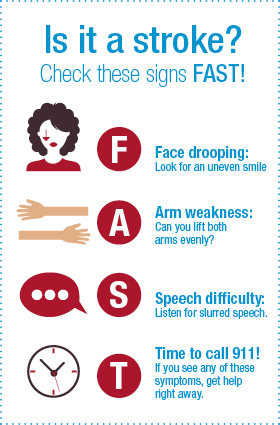Neurology (Brain & Nerves)
Stroke Care & Treatment in Red Wing
A stroke occurs when the blood supply to part of your brain is interrupted or severely reduced, depriving brain tissue of oxygen and nutrients. Within minutes, brain cells begin to die. A stroke is a medical emergency — immediate medical treatment is crucial. Early action can minimize brain damage and potential complications. Always call 911 at the first signs of stroke.
Learn more about stroke:
Stroke symptoms
If you think you or someone else may be having a stroke, note when your signs and symptoms begin because length of time may guide your treatment decisions.
Watch for these signs and symptoms:
- Trouble speaking or understanding
- Paralysis or numbness of the face, arm or leg
- Trouble seeing in one or both eyes
- A sudden, severe headache
Think FAST and do this:
- Face — Ask the person to smile. Does one side of the face droop?
- Arms — Ask the person to raise both arms. Does one arm drift downward? Or is one arm unable to be raised?
- Speech — Ask the person to repeat a simple phrase. Is speech slurred or strange?
- Time — If you observe any of these signs, call 911 immediately.
Stoke prevention
While everyone is at risk for stroke, you have the power to help protect yourself.
Follow these tips to reduce your risk of stroke:
- Control high blood pressure, or hypertension.
Know your numbers and keep them low. - Quit tobacco.
Smoking raises the risk of stroke. - Control diabetes.
You can manage diabetes with diet, exercise, weight control and medication. - Manage a healthy weight.
Being overweight contributes to other stroke risk factors, such as high blood pressure, cardiovascular disease and diabetes. Weight loss of as little as 10 pounds may lower your blood pressure and improve your cholesterol levels. - Eat a diet rich in fruits and vegetables.
A diet containing five or more daily servings of fruits or vegetables may reduce your risk of stroke. - Exercise.
Exercise can lower your blood pressure, increase your level of high-density lipoprotein cholesterol, and improve the overall health of your blood vessels and heart. It also helps you lose weight, control diabetes and reduce stress. - Drink alcohol in moderation, if at all.
Heavy alcohol consumption increases your risk of high blood pressure, ischemic strokes and hemorrhagic strokes. - Treat obstructive sleep apnea, if present.
Your healthcare provider may recommend an overnight oxygen assessment to screen for obstructive sleep apnea. If detected, it may be treated by giving you oxygen at night or having you wear a small device in your mouth. - Avoid illicit drugs.
Certain street drugs, such as cocaine and methamphetamines, are established risk factors for a transient ischemic attack, or TIA, or a stroke. - Manage medical conditions.
If you have any high cholesterol, carotid artery disease, peripheral artery disease, atrial fibrillation, or AFib, heart disease or sickle cell disease, get treatment and regular checkups.
While you can't control these risk factors, knowing about them can help you focus more on the factors you are able to change:
- Age
Although stroke is more common among the elderly, people under 65, including babies and children, also can have strokes. - Gender
Each year, stroke kills more women than men. Factors that may increase stroke risks for women include pregnancy, gestational diabetes, history of pre-eclampsia/eclampsia, oral contraceptive use, smoking and postmenopausal hormone therapy. - Race
African-Americans have a much higher risk of death from a stroke than Caucasians. - Family history
If your parent, grandparent, sister or brother has had a stroke, especially before age 65, you may be at a greater risk. - Prior stroke, TIA or heart attack
A person who has had any of these before is at a much higher risk of having another stroke. - Other risk factors
Other factors often linked to higher stroke risks include living in the southeastern U.S., having a lower income, drug and alcohol abuse, and not maintaining healthy sleep habits.
Katie Pace, a registered nurse, discusses what it means to be stroke ready:
Telestroke
In telestroke, physicians who have advanced training in the nervous system, called neurologists, remotely evaluate people who've had acute strokes and make diagnoses and treatment recommendations to emergency medicine providers at other sites. Doctors communicate using digital video cameras, internet telecommunications, robotic telepresence, mobile devices and other technologies.
Having a prompt neurological evaluation increases the possibility that you may receive clot-dissolving therapies, called thrombolytics, or other clot-retrieving procedures in time to reduce disability and death resulting from stroke.
